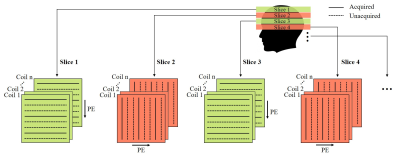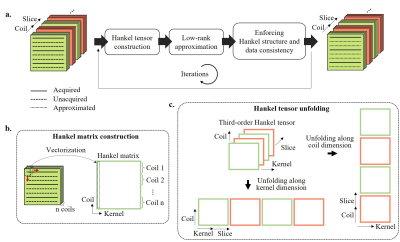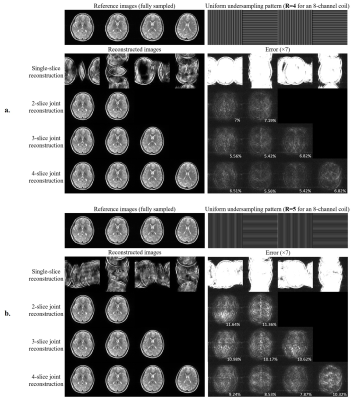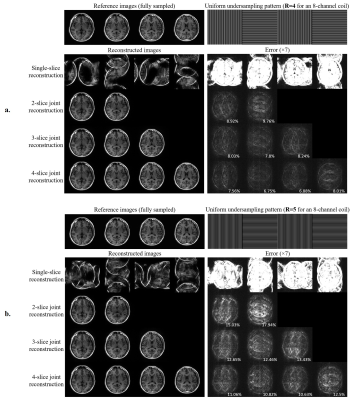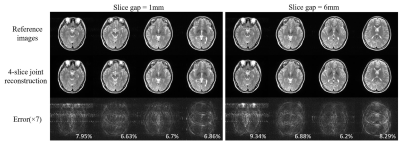3473
Calibration-free Highly Accelerated Multi-slice MRI via Alternating Phase Encoding Directions and Low-rank Tensor Completion Reconstruction1Laboratory of Biomedical Imaging and Signal Processing, The University of Hong Kong, Hong Kong, China, 2Department of Electrical and Electronic Engineering, The University of Hong Kong, Hong Kong, China, 3Department of Electrical and Electronic Engineering, Southern University of Science and Technology, Shenzhen, China, 4School of Biomedical Engineering, Southern Medical University, Guangzhou, China
Synopsis
2D multi-slice MR data share strong correlations in coil sensitivities and image contents over adjacent slices. Here we’ve developed a new acquisition and reconstruction strategy for calibration-free multi-slice MRI. In brief, k-space data for each slice are uniformly undersampled along one phase encoding direction, while undersampled data for next adjacent slice are acquired with phase encoding along an orthogonal direction. Multiple images are then jointly reconstructed using a low-rank Hankel tensor completion approach. This method maximizes the incoherence of aliasing artifacts, and utilizes the coil sensitivity and image content correlations across adjacent slices, leading to high accelerations with uniform undersampling.
Introduction
2D multi-slice Cartesian acquisition is widely used in clinical MRI. It potentially offers the flexibility of acquiring different slices with different sampling patterns, though this flexibility is rarely exercised. In this study, we propose a new acquisition and reconstruction strategy for calibration-free multi-slice MRI. Multi-slice Cartesian data are acquired with uniform undersampling while orthogonally alternating phase encoding directions. We then jointly reconstruct the multi-slice undersampled data through low-rank Hankel tensor completion to explicitly utilize the correlations in coil sensitivities and image contents across adjacent slices. Phase encoding direction alternation among adjacent slices enables aliasing artifacts to occur in two orthogonal directions, thus forcing them to be more incoherent during low-rank tensor completion. This new multi-slice acquisition and reconstruction strategy effectively suppresses aliasing artifacts, leading to high accelerations without coil sensitivity calibration.Methods
As shown in Fig.1, multi-slice Cartesian data are acquired with uniform undersampling while orthogonally alternating phase encoding directions. The multi-slice undersampled data are then jointly reconstructed through low-rank Hankel tensor completion approach as illustrated in Fig.2a.1) Tensor construction: For k-space data from each slice, a block-wise Hankel matrix is constructed by sliding a multi-channel kernel window across the k-space data (Fig. 2b). Multi-slice Hankel matrices are concatenated to form a third-order Hankel tensor.
2) Low-rank approximation: High-order singular value decomposition1 (HOSVD) is then applied to the third-order tensor. During the decomposition, the third-order tensor is respectively unfolded along coil and kernel dimensions (Fig. 2c) to obtain singular matrices by performing matrix SVD on unfolding matrices. Singular-value thresholding of the singular matrices is then applied to estimate the unacquired k-space data samples.
3) Hankel structure and data consistency: Hankel structure and data consistency constraints are performed, so that the tensor entries from the same k-space sample can be consistent and the tensor entries from acquired samples can match the acquisition.
4) Repeating above procedure iteratively till convergence.
Human brain data from healthy volunteers were acquired on a 3T Philips scanner using an 8-channel coil. 2D fast spin echo (FSE) was applied to acquire T2-weighted and T1-weighted inversion recovery (IR) datasets with TR/TE=3000/86ms and TR/TE/TI=2000/20/800ms, respectively. Both datasets were acquired with slice thickness/gap=4/1mm. K-space data were retrospectively undersampled with the proposed acquisition strategy. The kernel window size for Hankel matrix construction was 6×6. Normalized root-mean-square errors (NRMSE) were measured to assess reconstruction performance.
Results
Figs. 3-5 show the reconstruction performance of our proposed method. Fig. 3 and Fig. 4 present reconstruction results for T2-weighted and T1-weighted IR data with different acceleration factors. The undersampled data were also independently reconstructed through single-slice based reconstruction method (simultaneous autocalibrating and k-space estimation, SAKE2). Our strategy achieved a clear improvement than single-slice based method in suppressing aliasing artifacts. The improvement increased with the number of slices, in terms of less reconstruction error and smaller NRMSE. Fig. 5 demonstrates that our proposed method utilized correlations across slices. The reconstruction error increased with slice gap due to the reduction of similarities in coil sensitivities and image contents, as expected.Discussion and Conclusions
In conclusion, this study presents a novel and robust 2D multi-slice Cartesian acquisition and low-rank tensor completion reconstruction strategy for highly accelerated MRI without coil sensitivity calibration. This strategy can be easily implemented in practice, and deployed to reconstruct the traditionally undersampled datasets (i.e., with uniform undersampling). The superior performance of our proposed method is based on the rationales that, by jointly reconstructing multi-slice uniformly undersampled data acquired with orthogonally alternating phase encoding directions, the incoherence of aliasing artifacts from adjacent slices can be maximized, and each slice can utilize complementary information along its undersampling direction from adjacent slices. The proposed method resulted in effective suppression of aliasing artifacts, leading to very high accelerations. On the contrary, single-slice based SAKE failed completely in all reconstruction experiments because uniform undersampling pattern introduced extremely coherent aliasing artifacts for each slice. Further studies can be carried out in two areas. First, our proposed method needs to be experimentally examined and optimized (e.g., in terms of kernel window size and number of slices for joint reconstruction) for various acquisition geometries, organs and contrasts. Note that, in practice, orthogonally alternating phase encoding direction may introduce slight data inconsistency among adjacent slices due to hardware imperfections, such as slight image phase changes caused by gradient eddy currents. However, such minor image phase changes will be spatially smooth and can be estimated and corrected through iterative approaches. Second, the proposed method can be extended to achieve even higher accelerations without coil calibration. One example is to combine our multi-slice strategy with the recently proposed multi-contrast MRI3 by jointly reconstructing multi-slice multi-contrast datasets via low-rank tensor completion. The other example is to apply this strategy for dynamic multi-slice acquisitions including cardiac MRI and contrast-enhanced dynamic MRI.Acknowledgements
This study is supported in part by Hong Kong Research Grant Council (C7048-16G and HKU17115116 to E.X.W.), Guangdong Key Technologies for Treatment of Brain Disorders (2018B030332001) and Guangdong Key Technologies for Alzheimer's Disease Diagnosis and Treatment (2018B030336001) to E.X.W.References
1. T. G. Kolda, and B. W. Bader, “Tensor decomposition and applications,” SIAM review, vol. 51, pp. 455–500, 2009.
2. P. J. Shin, P. E. Larson, M. A. Ohliger, M. Elad, J. M. Pauly, D. B. Vigneron, and M. Lustig, "Calibrationless parallel imaging reconstruction based on structured low-rank matrix completion," Magnetic Resonance in Medicine, vol. 72, pp. 959–970, 2014.
3. Z. Yi, Y. Liu, Y. Zhao, F. Chen, and E. X. Wu, “Joint calibrationless reconstruction of highly undersampled multi-contrast MR datasets using a novel low-rank completion approach,” 27th Annual Meeting of ISMRM, No. 4746, 2019.
Figures
